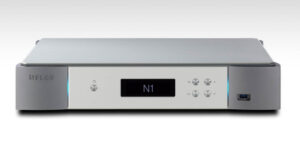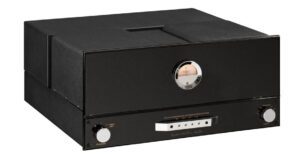
We have already touched upon the Stax SR-009. Our Publisher, Chris Martens, has a great deal of respect for the product, both when it is driven by Stax‘energisers’ (Stax-speak for electrostatic headphone amplifiers) and especially third-party electrostatic amps. But, the audiophile is an odd breed, and Chris’ passion for high-end headphones and earphones can sometimes be met with a simple dismissal by those still wedded to their loudspeakers. But in real terms where does the Stax SR-009 (accompanied this time by the SRM-007tIIenergiser) stand in relation to the wider audiophile world?
There’s not much I can say about the SR-009 that people don’t already know. It’s the flagship electrostatic ‘ear speaker’ from a company best known and associated with electrostatic headphones, which need a purpose-built electrostatic amplifier or ‘energiser’ (not simply a conventional headphone amplifier). Also, the whole system costs as much as a good second-hand car.
However, where a flagship design typically adds to the standard range, there is next to nothing on the SR-009 shared with the rest of the range. Even down to the diaphragm material. The SR-009 uses an ultra-thin film in place of the usual reinforced engineering plastics, because it has all the properties needed by an electrostatic diaphragm, but with more resilience. It doesn’t come cheap. Neither do the photo-etched multi-layer electrodes (or ‘MLER’: not the best acronym, unless you speak fluent zombie) that drive the whole diaphragm itself. The enclosure itself is a traditional circular shape, as opposed to wearing two rectangular boxes on your ears as in the 207-507 models, and this is more ear-shaped like the 007s and other headphones. The aluminium outer ring connects to the headband with a tried-and-trusted gimballed connection, which means it’s a universally comfortable design (you’d have to have a really weird head not to find these comfy). While the former 007 flagship comes in a spiffy flight case, the 009 oozes class in its wooden box.
It connects, via a flat cable and a moulded five-pin plug to one of a range of energisers; high voltage amplifiers designed specifically for the task of driving those stator ear panels. As mentioned previously, we used the top Stax flagship, the SRM-007tII. This uses two pairs of 6FQ7 tubes in the output stage, and a FET input stage, running pure balanced and in full Class A. Symmetry ‘hot rods’ the SRM-007tII slightly in its ‘Kimik’ guise, with a spot of cryo treatment for the tubes, gold plated pins and EAT tube dampers, adding an extra £200 to the base price. These 6FQ7s are not there for show, or to soften or warm up the sound. They are there because high-voltage electronics was more of a ‘thing’ in the age of tubes, and although solid-state can also be used in high-voltage capacities, this is one place where hollow-state technology has indisputable benefits, that do not just fall to ‘sounding nice’.
The SRM-007tII can take balanced or single-ended audio inputs, but it is distinctly balanced in design, and this perfectly fits the performance parameters of the inherently balanced SR-009. Dedicated headphone enthusiasts could use this in place of an amplifier entirely, while more traditional audiophiles would simply connect it to a line or tape output. It’s an unfussy performer, not requiring careful handling, is not inherently cable fussy or platform sensitive, and despite having four glowing bottles inside, isn’t particularly microphonic. That being said, the SR-009s can show up the difference between good, better, and best quality sources with ease and if you are wanting to show off how good your new cables sound, you’ll hear everything through the SR-009s.

Curiously though, the first reaction to the SR-009 sound is a vacillation between two states. The first is ‘meh!’, and the second is ‘I wonder how that album sounds on these?’ In fact, these are variations on the same theme, and it’s the Stax busily re-writing just what you think of as ‘good’. There is nothing intrinsically impressive about the SR-009, and that is paradoxically what is so impressive about the SR-009. You begin to realise (and realise pretty quickly) that what appears good about other transducers is a sham; a ‘smoke and mirrors’ trick to make music ‘showy’ sounding, where the Stax combo is the real deal.
It’s so damn unflappable. Put on some fabulously well-recorded piece of audiophile material (Anne Bisson’s new self-published Tales from the Treetops, for example), and you get a sound of remarkable space, clarity and inner detail. But this is what audiophile recordings are made for, they impress throughout. Whip on something more dirty, such as ‘Girl, You have no Faith in Medicine’ from The White Stripes Elephant [XL], and you get raucous, stripped to the bone lo-fi rocking blues at its most energetic.
But it’s the points in between these two poles where the Stax flagship really comes into its own. Once you begin to drill down into what this headphone system can do, it’s truly staggering. A good speaker system can let you hear the reverb tails of a studio recording as distinct from the instrument itself; the Stax gets even deeper and lets you hear the difference between different styles of reverb. You’ll hear if the engineer has had to pull out some of his or her tool kit to ‘tickle up’ a vocal, and you’ll be surprised at how subtle auto-tune can be and how often it is used today. Edits and cut-ins are impossible to miss, the subtle use of compression on the guitar part in a not-so-subtle signal compressed sound becomes clear (even ‘Things We Lost In The Fire’ by Bastille became fascinating rather than infuriating as a result). And, dispel any suggestion about electrostatics and volume; if you are hearing distortion that isn’t on the album, it’s your ears crying for mercy. There is no distortion, there is no colouration, there is just the music, and it’s a breathtaking ride through your collection.
However, there are some who react to the SR-009 instantaneously, complaining of a lack of bass. However, those who have spent any time with the SR-009, who have come to realise what the ‘ear speaker’ system really, really does are divided into pitying these poor deluded souls, and wanting to hunt them for sport. It’s not ‘bass light’, it’s ‘bass right’; a sound of remarkable depth and precision, free from bloat, overhang, imprecision, and flab.
Finally, we return to the original question: what does a loudspeaker-wielding hi-fi buff think about the top of the Stax tree? Put simply, ‘wow!’ In detail resolution and clarity, I wonder if there is a loudspeaker out there (irrespective of price, design, or technology) that comes close to what the SR-009 can offer.
There are few things in life that can be bought and which are incontrovertibly among ‘the best’, but the Stax SR-009 is a part of that select band. Perhaps the best praise I can lay at the door of Stax is the day after these headphones went back, I mourned their loss, and stopped listening to music for a week (which in my job is practically a resignation letter). These headphones aren’t just ‘good’; they are tantamount to a life-changing experience for the open-minded audiophile. They are the last loudspeakers you will ever own.
Technical Specifications
SR-009
- Type: Push-pull circumaural, open-back, electrostatic headphone.
- Frequency response: 5Hz – 42kHz
- Electrostatic Capacitance: 110pF (including cable)
- Impedance: 145kOhms nominal (including cable)
- Sensitivity: 101dB/100V rms @ 1kHz
- Maximum Sound Pressure: 118dB/400Hz
- Bias Voltage: 580V DC.
- Accessories: Wood presentation case
- Weight: 590g (with signal cables).
- Price: £3,495
- SRM-007tII ‘Kimik’
- Type: Vacuum tube output stage Low noise dual FET input Class A operation, Pure balance DC amplifier configuration Earspeaker driver unit
- Vacuum Tubes: 4x 6QF7/6CG7
- Inputs: two stereo single-ended (via RCA jacks), one stereo balanced (via dual 3-pin XLR jacks)
- Outputs: one RCA parallel output, five pin balanced headphone socket (x2)
- Frequency response: DC – 100kHz, +0dB, -1.5dB
- THD+N: Max. 0.02%, (1kHz, 100V rms)
- Dynamic Range: not specified
- Rated Input Level: 200mV/100V outputs
- Maximum Input Level: 30V rms at min. volume
- Maximum Output Level: 340V rms (1kHz)
- Dimensions (HxWxD): 104 x 195 x 420mm
- Weight: 4.7kg
- Price: £2,295
Manufacturer: Stax Ltd
URL: www.stax.co.jp
Back to reviews https://hifiplus.com/reviews
Tags: FEATURED
By Alan Sircom
More articles from this authorRead Next From Review
See all
Reiki Audio SuperSwitch Master Pro + Servant Pro
- Mar 27, 2024

Melco Audio N1-S38 music server
- Mar 27, 2024

Focal Utopia 2022 headphones
- Mar 27, 2024











